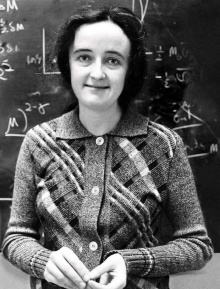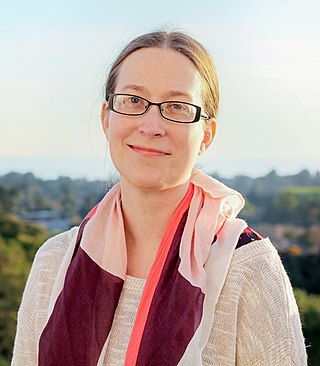
Julianne Dalcanton (born 1968) is an American astronomer, professor of astronomy, researcher and comet discoverer. [1] Since September 2021 she is the director of the Simons Foundation Center for Computational Astrophysics. [2]

Julianne Dalcanton (born 1968) is an American astronomer, professor of astronomy, researcher and comet discoverer. [1] Since September 2021 she is the director of the Simons Foundation Center for Computational Astrophysics. [2]
Julianne Dalcanton joined the Simons Foundation in September 2021 as Director of the Flatiron Institute’s Center for Computational Astrophysics (CCA) in NYC. [3] Prior to this she was Professor of Astronomy, University of Washington, Chair of the Astronomy Department, and researcher for Sloan Digital Sky Survey. Her main work is on the area of galaxy formation and evolution. She led the ACS Nearby Galaxy Survey Treasury (ANGST) and is leading the Panchromatic Hubble Andromeda Treasury (PHAT) programs on the Hubble Space Telescope. [4] She became known worldwide by her discovery of the comet C/1999 F2 Dalcanton. She is also a contributor to the physics blog Cosmic Variance.
In 2018, Professor Dalcanton was awarded the Beatrice M. Tinsley Prize by the American Astronomical Society in recognition of her work in Astronomy and "contributions that are of an exceptionally creative or innovative character and that have played a seminal role in furthering our understanding of the universe." [5] [6] Asteroid 148384 Dalcanton, discovered by the Sloan Digital Sky Survey in 2000, was named in her honor. [1] The official naming citation was published by the Minor Planet Center on 6 April 2012 ( M.P.C. 79106). [7]

Fornax is a constellation in the southern celestial hemisphere, partly ringed by the celestial river Eridanus. Its name is Latin for furnace. It was named by French astronomer Nicolas Louis de Lacaille in 1756. Fornax is one of the 88 modern constellations.

Sandra Moore Faber is an American astrophysicist known for her research on the evolution of galaxies. She is the University Professor of Astronomy and Astrophysics at the University of California, Santa Cruz, and works at the Lick Observatory. She has made discoveries linking the brightness of galaxies to the speed of stars within them and was the co-discoverer of the Faber–Jackson relation. Faber was also instrumental in designing the Keck telescopes in Hawaii.

An Einstein ring, also known as an Einstein–Chwolson ring or Chwolson ring, is created when light from a galaxy or star passes by a massive object en route to the Earth. Due to gravitational lensing, the light is diverted, making it seem to come from different places. If source, lens, and observer are all in perfect alignment, the light appears as a ring.
The Beatrice M. Tinsley Prize is awarded every other year by the American Astronomical Society in recognition of an outstanding research contribution to astronomy or astrophysics of an exceptionally creative or innovative character. The prize is named in honor of the cosmologist and astronomer Beatrice Tinsley.

Beatrice Muriel Hill Tinsley was a British-born New Zealand astronomer and cosmologist, and the first female professor of astronomy at Yale University, whose research made fundamental contributions to the astronomical understanding of how galaxies evolve, grow and die.

A dwarf galaxy is a small galaxy composed of about 1000 up to several billion stars, as compared to the Milky Way's 200–400 billion stars. The Large Magellanic Cloud, which closely orbits the Milky Way and contains over 30 billion stars, is sometimes classified as a dwarf galaxy; others consider it a full-fledged galaxy. Dwarf galaxies' formation and activity are thought to be heavily influenced by interactions with larger galaxies. Astronomers identify numerous types of dwarf galaxies, based on their shape and composition.
Amy J. Barger is an American astronomer and Henrietta Leavitt Professor of Astronomy at the University of Wisconsin–Madison. She is considered a pioneer in combining data from multiple telescopes to monitor multiple wavelengths and in discovering distant galaxies and supermassive black holes, which are outside of the visible spectrum. Barger is an active member of the International Astronomical Union.

NGC 290 is an open cluster of stars in the southern constellation of Tucana. This cluster was discovered September 5, 1826 by Scottish astronomer James Dunlop. It lies some 200,000 light years away from the Sun in the Small Magellanic Cloud galaxy. The cluster is an estimated 30–63 million years old and is around 65 light years across.
Sebastian Florian Hönig is a German astronomer, Professor of Observational & Computational Astrophysics in the astronomy group of the University of Southampton School of Physics & Astronomy, and discoverer of minor planets and comets.

Wendy Laurel Freedman is a Canadian-American astronomer, best known for her measurement of the Hubble constant, and as director of the Carnegie Observatories in Pasadena, California, and Las Campanas, Chile. She is now the John & Marion Sullivan University Professor of Astronomy and Astrophysics at the University of Chicago. Her principal research interests are in observational cosmology, focusing on measuring both the current and past expansion rates of the universe, and on characterizing the nature of dark energy.
Stanislav George Djorgovski is an American scientist and scholar. He obtained his B.A. in astrophysics in 1979 at the University of Belgrade. After receiving his PhD in astronomy from U.C. Berkeley in 1985, he was a Harvard Junior Fellow until 1987 when he joined the faculty at the California Institute of Technology, where he is currently a professor of astronomy and data science.
Adam Burrows is a noted professor of astrophysical sciences at Princeton University.
Alice Eve Shapley is a professor at the University of California, Los Angeles (UCLA) in the Department of Physics and Astronomy. She was one of the discoverers of the spiral galaxy BX442. Through her time at University of California, Los Angeles (UCLA) she has taught Nature of the Universe, Black Holes and Cosmic Catastrophes,Cosmology: Our Changing Concepts of the Universe, Galaxies, Scientific Writing, AGNs, Galaxies, *and* Writing, and The Formation and Evolution of Galaxies and the IGM. Shapley has committed herself too over a two decades of research and publication in the interest of physics and astronomy.

Beth Willman is an American astronomer who is the Executive Officer of the LSST Corporation, an astronomical organization notable for its support of the Vera C. Rubin Observatory. She was previously the deputy director of the National Optical-Infrared Astronomy Research Laboratory (NOIRLab) and an associate professor of astronomy at Haverford College.

Laura Ferrarese is a researcher in space science at the National Research Council of Canada. Her primary work has been performed using data from the Hubble Space Telescope and the Canada-France-Hawaii Telescope.
Karin Ingegerd Öberg is a Swedish astrochemist. She is a Professor of Astronomy at Harvard University and leader of the Öberg Astrochemistry Group at the Center for Astrophysics | Harvard & Smithsonian. Her research concerns star formation, planet formation, and stellar evolution in relation to organic molecules, which are necessary to determine the origins of life on Earth and elsewhere. In April 2015, her group discovered the first complex organic molecule in a protoplanetary disk.
The Flatiron Institute is an American internal research division of the Simons Foundation, launched in 2016. It comprises five centers for computational science: the Center for Computational Astrophysics (CCA); the Center for Computational Biology (CCB); the Center for Computational Quantum Physics (CCQ); the Center for Computational Mathematics (CCM); and the Center for Computational Neuroscience (CCN). It also has a group called the Scientific Computing Core (SCC). The institute takes its name from the Flatiron District in New York City where it's based.

NGC 4302 is an edge-on spiral galaxy located about 55 million light-years away in the constellation Coma Berenices. It was discovered by astronomer William Herschel on April 8, 1784 and is a member of the Virgo Cluster.
Evan David Skillman is an American astronomer and astrophysicist.

Dr Aki Roberge is a research astrophysicist at NASA’s Goddard Space Flight Center, where she is currently the Associate Director for Technology and Strategy. Her research focuses on observational studies of debris disks and planet formation around nearby young stars, with an aim to be able to characterize planets around other stars, perhaps even to find signs of life on them. She is particularly known for her research on the debris disk around Beta Pictoris.